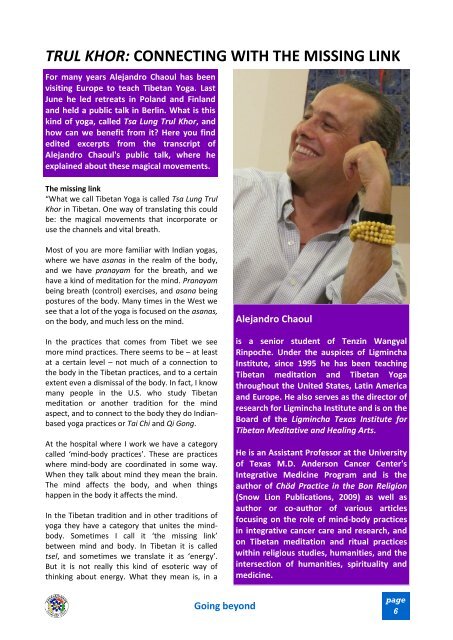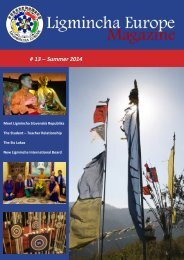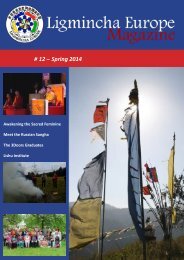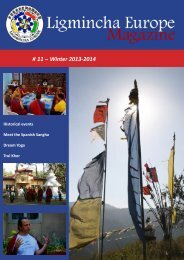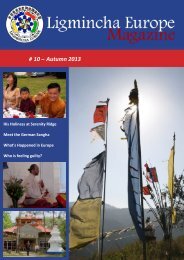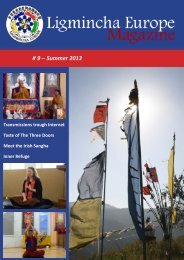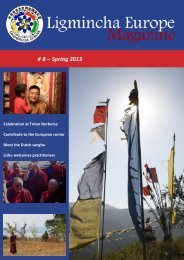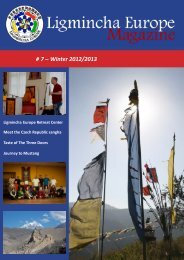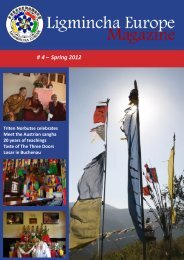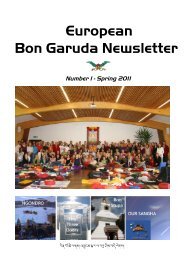Ligmincha Europe Magazine # 6 – Autumn 2012
European Magazine of the Ligmincha Sangha of Tenzin Wangyal Rinpoche. Informs about news, events, teachings and projects within the Bon-Buddhist Sangha.
European Magazine of the Ligmincha Sangha of Tenzin Wangyal Rinpoche. Informs about news, events, teachings and projects within the Bon-Buddhist Sangha.
Create successful ePaper yourself
Turn your PDF publications into a flip-book with our unique Google optimized e-Paper software.
TRUL KHOR: CONNECTING WITH THE MISSING LINK<br />
For many years Alejandro Chaoul has been<br />
visiting <strong>Europe</strong> to teach Tibetan Yoga. Last<br />
June he led retreats in Poland and Finland<br />
and held a public talk in Berlin. What is this<br />
kind of yoga, called Tsa Lung Trul Khor, and<br />
how can we benefit from it? Here you find<br />
edited excerpts from the transcript of<br />
Alejandro Chaoul's public talk, where he<br />
explained about these magical movements.<br />
The missing link<br />
“What we call Tibetan Yoga is called Tsa Lung Trul<br />
Khor in Tibetan. One way of translating this could<br />
be: the magical movements that incorporate or<br />
use the channels and vital breath.<br />
Most of you are more familiar with Indian yogas,<br />
where we have asanas in the realm of the body,<br />
and we have pranayam for the breath, and we<br />
have a kind of meditation for the mind. Pranayam<br />
being breath (control) exercises, and asana being<br />
postures of the body. Many times in the West we<br />
see that a lot of the yoga is focused on the asanas,<br />
on the body, and much less on the mind.<br />
In the practices that comes from Tibet we see<br />
more mind practices. There seems to be <strong>–</strong> at least<br />
at a certain level <strong>–</strong> not much of a connection to<br />
the body in the Tibetan practices, and to a certain<br />
extent even a dismissal of the body. In fact, I know<br />
many people in the U.S. who study Tibetan<br />
meditation or another tradition for the mind<br />
aspect, and to connect to the body they do Indianbased<br />
yoga practices or Tai Chi and Qi Gong.<br />
At the hospital where I work we have a category<br />
called ‘mind-body practices’. These are practices<br />
where mind-body are coordinated in some way.<br />
When they talk about mind they mean the brain.<br />
The mind affects the body, and when things<br />
happen in the body it affects the mind.<br />
In the Tibetan tradition and in other traditions of<br />
yoga they have a category that unites the mindbody.<br />
Sometimes I call it ‘the missing link’<br />
between mind and body. In Tibetan it is called<br />
tsel, and sometimes we translate it as ‘energy’.<br />
But it is not really this kind of esoteric way of<br />
thinking about energy. What they mean is, in a<br />
Going beyond<br />
Alejandro Chaoul<br />
is a senior student of Tenzin Wangyal<br />
Rinpoche. Under the auspices of <strong>Ligmincha</strong><br />
Institute, since 1995 he has been teaching<br />
Tibetan meditation and Tibetan Yoga<br />
throughout the United States, Latin America<br />
and <strong>Europe</strong>. He also serves as the director of<br />
research for <strong>Ligmincha</strong> Institute and is on the<br />
Board of the <strong>Ligmincha</strong> Texas Institute for<br />
Tibetan Meditative and Healing Arts.<br />
He is an Assistant Professor at the University<br />
of Texas M.D. Anderson Cancer Center's<br />
Integrative Medicine Program and is the<br />
author of Chöd Practice in the Bon Religion<br />
(Snow Lion Publications, 2009) as well as<br />
author or co-author of various articles<br />
focusing on the role of mind-body practices<br />
in integrative cancer care and research, and<br />
on Tibetan meditation and ritual practices<br />
within religious studies, humanities, and the<br />
intersection of humanities, spirituality and<br />
medicine.<br />
page<br />
6


